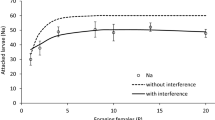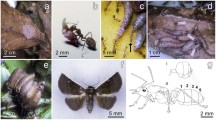Abstract
This study examines the oviposition behavior of the phorid parasitoid Neodohrniphora curvinervisand the antiparasitoid defense behavior of its leafcutting ant host Atta cephalotes. N. curvinervisfemales are diurnal sit- and- wait parasitoids that attack only outbound foragers of head width 1.6 mm or greater. Females deposit a single egg through the foramen magnum of each host successfully parasitized. Pursuit of hosts is usually initiated when an outbound forager of acceptable size passes by a parasitoid perch site. Individual foragers defend themselves against pursuing parasitoids by outrunning them along the foraging trail or by standing their ground and fending them off with their legs,antennae, and mandibles. At the colony level, susceptible foragers are protected against parasitism by a shift in the forager size distribution toward smaller unsusceptible sizes during the day when parasitoids are active and toward larger sizes at night when parasitoids are inactive. The frequency of parasitism of susceptible foragers was 15%, which is more than five times the frequency found in another system involving the phorid parasitoid Apocephalus attophilusand the leafcutting ant host Atta colombica.We offer several possible explanations for such differences in the frequency of parasitism and also examine reasons for the high incidence of superparasitism (19%) observed in the system studied.
Similar content being viewed by others
References
Borgmeier, T. (1931). Sobre alguns phorideos que parasitam formigas a sáuva e outras formigas cortadeiras (Diptera, Phoridae).Arch. Inst. Biol. (SÃo Paulo)14: 119–126.
Charnov, E. R., and Skinner, S. W. (1984). Evolution of host selection and clutch size in parasitoid wasps.Fla. Entomol. 67: 5–21.
Cherrett, J. M. (1968). The foraging behavior ofAtta cephalotes (L.) (Hymenoptera: Formicidae). I. Foraging pattern and plant species attacked in tropical rain forest.J. Anim. Ecol. 37: 387–403.
Cherrett, J. M. (1972). Some factors involved in the selection of vegetable substrate byAtta cephalotes (L.) (Hymenoptera: Formicidae) in tropical rain forest.J. Anim. Ecol. 41: 647–660.
Clark, D. B. (1989). The search for solutions: research and education at the La Selva Station and their relation to ecodevelopment. In Almeda, F., and Pringle, C. M. (eds.),Tropical Rainforests: Diversity and Conservation, California Academy of Sciences Press, San Francisco, pp. 209–224.
Feener, D. H., Jr. (1988). Effects of parasites on foraging and defense behavior of a termitophagous ant,Pheidole titanis Wheeler (Hymenoptera: Formicidae).Behav. Ecol. Sociobiol. 22: 421–427.
Feener, D. H., Jr., and Moss, K. T. A. (1990). Defense against parasites by hitchhikers in leafcutting ants: A quantitative assessment.Behav. Ecol. Sociobiol. 26: 17–29.
Gardner, S. M., Ward, S. A., and Dixon, A. F. G. (1984). Limitation of superparasitism byAphidius rhopalosiphi: a consequence of aphid defense behavior.Ecol. Entomol. 9: 149–155.
Iwasa, Y., Suzuki, Y., and Matsuda, H. (1984). Theory of oviposition strategy of parasitoids. I. Effect of mortality and limited egg number.Theor. Pop. Biol. 26: 205–227.
Lewis, T., Pollard, G. V., and Dibley, G. C. (1974a). Rhythmic foraging in the leaf-cutting antAtta cephalotes (L.) (Formicidae: Attini).J. Anim. Ecol. 43: 129–141.
Lewis, T., Pollard, G. V., and Dibley, G. C. (1974b). Microenvironmental factors affecting diel patterns of foraging in the leaf-cutter antAtta cephalotes. J. Anim. Ecol.43: 143–153.
Mangel, M. (1989). An evolutionary interpretation of the “motivation to oviposit.”J. Evol. Biol. 2: 157–172.
Orr, M. (1992). Parasitic flies (Diptera: Phoridae) influence foraging rhythms of the leafcutter antAtta cephalotes. Behav. Ecol. Sociobiol.30: 395–402.
Rockwood, L. L. (1975). The effects of seasonality on foraging in two species of leaf-cutting ants (Atta) in Guanacaste Province, Costa Rica.Biotropica 7: 176–193.
Salt, G. (1934). Experimental studies in insect Parasitism. II. Superparasitism.Proc. Roy. Soc. B 114: 455–476.
Speirs, D. C., Sherratt, T. N., and Hubbard, S. F. (1991). Parasitoid diets: does superparasitism pay?Trends Ecol. Evol. 6: 22–25.
Stradling, D. J. (1978). The influence of size on foraging in the ant,Atta cephalotes, and the effect of some plant defense mechanisms.J. Anim. Ecol. 47: 173–188.
van Alphen, J. J. M., and Visser, M. E. (1990). Superparasitism as an adaptive strategy for insect parasitoids.Annu. Rev. Entomol. 35: 59–79.
Waller, D. A., and Moser, J. C. (1990). Invertebrate enemies and nest associates of the leaf-cutting antAtta texana (Buckley) (Formicidae, Attini). In Vander Meer, R. K., Jaffe, K., and Cedeno (eds.),Applied Myrmecology, Westview Press, Boulder, CO, pp. 255–273.
Wetterer, J. K. (1990). Diel changes in forager size, activity, and load selectivity in a tropical leafcutting ant,Atta cephalotes.Ecol. Entomol. 15: 97–104.
Author information
Authors and Affiliations
Rights and permissions
About this article
Cite this article
Feener, D.H., Brown, B.V. Oviposition behavior of an ant-parasitizing fly,Neodohrniphora curvinervis (Diptera: Phoridae), and defense behavior by its leaf-cutting ant hostAtta cephalotes (Hymenoptera: Formicidae). J Insect Behav 6, 675–688 (1993). https://doi.org/10.1007/BF01201669
Accepted:
Issue Date:
DOI: https://doi.org/10.1007/BF01201669




